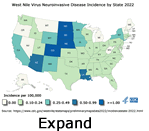Introduction
Key facts about West Nile disease (CDC 2019)
West Nile virus (WNV) is the leading mosquito-borne disease in the continental United States. It is most commonly spread to people by the bite of an infected mosquito. Cases of WNV occur during mosquito season, which starts in the summer and continues through fall. There are no vaccines to prevent or medications to treat WNV in people. Fortunately, most people infected with WNV do not feel sick. About 1 in 5 people who are infected develop a fever and other symptoms. About 1 out of 150 infected people develop a serious, sometimes fatal, illness. You can reduce the risk of WNV by using insect repellent and wearing long-sleeved shirts and long pants to prevent mosquito bites.
The history of WNV in the USA
In 1999 a significant outbreak of WNV neuroinvasive disease was identified in the New York city area. A coincident die off of corvid birds served to further heighten concern. Initially, St. Louis encephalitis was suspected, but tests on the birds confirmed West Nile Virus (WNV). Until then, WNV had not been confirmed in the Western hemisphere.
New York public health officials understood the threat posed by WNV. They implemented mosquito eradication programs, fearing that WNV would spread as the birds migrated south. Those fears proved to be well founded. Despite their efforts, the disease spread south, north and west as well.
By the end of 1999, WNV had been detected in 4 states; by 2000, it had spread to 8 states; and by 2001, to 22 states and Ontario, Canada. In 2002, the greatest number of cases were in Illinois; in 2003, in Colorado; and in 2004, in California, showing the inexorable march of the infection across the United States.
Since then, Cases of West Nile virus (WNV) have been reported in states across the continental United States. WNV activity typically occurs during the summer months and into the fall. The annual number of reported WNV disease cases can fluctuate widely, as a result of periodic epidemics. All residents of and visitors to areas where WNV activity has been identified are at risk of WNV infection, particularly people who engage in outdoor work and recreational activities.
 The largest identified single outbreak in U.S. history of West Nile virus disease, a potentially fatal mosquito-borne illness, occurred in Arizona the summer of 2021. Over 1,600 cases of West Nile virus disease were reported in the summer and fall of 2021, with the outbreak centered in Maricopa County (1,463 cases reported to Arizona Department of Public Health as of 3/28/2022) (Holcomb, K. 2022).
The largest identified single outbreak in U.S. history of West Nile virus disease, a potentially fatal mosquito-borne illness, occurred in Arizona the summer of 2021. Over 1,600 cases of West Nile virus disease were reported in the summer and fall of 2021, with the outbreak centered in Maricopa County (1,463 cases reported to Arizona Department of Public Health as of 3/28/2022) (Holcomb, K. 2022).
West Nile virus disease is a nationally notifiable condition. Cases are reported to CDC by state and local health departments using standard case definitions. Arboviral surveillance data are reported to CDC through ArboNET. In addition to human disease, ArboNET maintains data on arboviral infections among presumptive viremic blood donors, veterinary disease cases, mosquitoes, dead birds, and sentinel animals.
The CDC recommends that West Nile virus (WNV) disease should be considered in any person with a febrile or acute neurologic illness who has had recent exposure to mosquitoes, blood transfusion, or organ transplantation, especially during the summer months in areas where virus activity has been reported (CDC).
Instant feedback:
WNV has spread quickly since 1999, infecting people in North America.
Reference
CDC. West Nile Virus
Retreived 6/12/23. https://www.cdc.gov/westnile/index.html
CDC. West Nile virus. Statistics and Maps. Retrieved 6/12/2023
https://www.cdc.gov/westnile/statsmaps/index.html
Holcomb, K (2022). Worst-ever U.S. West Nile virus outbreak potentially linked to a wetter-than-average 2021 Southwest monsoon. National Oceanic and Atmospheric Administration (NOAA). Climate gov Accessed 6/12/2023 from https://www.climate.gov/news-features/features/worst-ever-us-west-nile-virus-outbreak-potentially-linked-wetter-average
Kent R, Juliusson L, Weissmann M, Evans S, Komar N. (2009) Seasonal blood-feeding behavior of Culex tarsalis (Diptera: Culicidae) in Weld County, Colorado, 2007. J Med Entomol. 46(2):380-90.
© RnCeus.com
 The largest identified single outbreak in U.S. history of West Nile virus disease, a potentially fatal mosquito-borne illness, occurred in Arizona the summer of 2021. Over 1,600 cases of West Nile virus disease were reported in the summer and fall of 2021, with the outbreak centered in Maricopa County (1,463 cases reported to Arizona Department of Public Health as of 3/28/2022) (Holcomb, K. 2022).
The largest identified single outbreak in U.S. history of West Nile virus disease, a potentially fatal mosquito-borne illness, occurred in Arizona the summer of 2021. Over 1,600 cases of West Nile virus disease were reported in the summer and fall of 2021, with the outbreak centered in Maricopa County (1,463 cases reported to Arizona Department of Public Health as of 3/28/2022) (Holcomb, K. 2022).